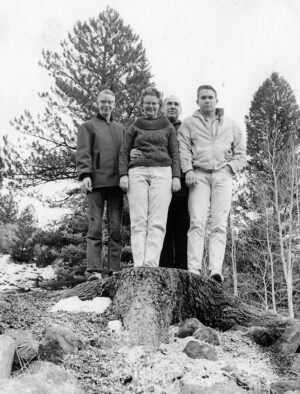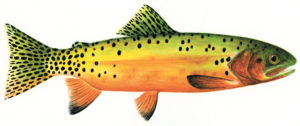When I heard that the theme of this month’s Central would be Colorado facts, I started scanning my bookshelves. There were tomes about Colorado wildlife, place names, trees, flowers, mountains, trails, festivals, people and history. I quickly narrowed my options by concentrating on the books that I could reach without using a ladder, which left me with several rows of Colorado histories and biographies.
And that’s how I decided to write about people. After paging through the indexes of a few dozen books, I realized that many of our state’s most famous residents weren’t born in Colorado. And a lot of the celebrities who were, didn’t earn their fame here.
Jedediah Smith, the celebrated mountain man, was born in New York state in 1799. Meyer Guggenheim was born in Switzerland in 1828 and found fame and fortune with Leadville mining operations and his Pueblo smelting company, then endowed artists and art museums worldwide. Harold Ross was born in Aspen in 1892, and founded The New Yorker magazine.
Coloradans popularized in song, story and legend include Kit Carson, Doc Holliday, Bat Masterson, Soapy Smith, Mattie Silks and Buffalo Bill. Coloradans frequently featured in history books include Zebulon Pike, the Bent brothers, John Wesley Powell, and Chief Ouray.
In this small sampling of famous Coloradans, some were born here, some settled here, and some were just passing through. Were they all really Coloradans? Maybe not.
But does it matter? Of course not; it’s not as if they’re going to register to vote.
However, it may matter that many Coloradans are more famous for their fictional exploits – as related by Hollywood and pulp westerns – than their real accomplishments.
The penny press, wild west shows and western novelists captured the romance and thrills of our region, and they even made our scofflaws and prostitutes seem appealing.
[InContentAdTwo]
But what makes particular people stand out in history, be they outlaws or lawmen, soldiers or prostitutes?
Sadly, history appears to be almost as arbitrary about whom it selects as I am. The reputations of John Charles Fremont, George Armstrong Custer and Wyatt Earp were largely helped along by their wives, who were all dedicated publicists and promoters of their spouses. Jessie Fremont and Libby Custer shamelessly romanticized their husbands’ exploits into popular prose, and Josephine Earp lived long enough to inform Hollywood filmmakers about Wyatt’s valiant adventures. If you want objectivity about a person, you probably shouldn’t rely on their loved ones for details.
But I doubt that objectivity is what we want from history. What we want is heroes and villains, inspiration and hope. And that’s what we get – along with villains, to explain away why our nobility and daring haven’t resulted in a perfect world.
In the 1970s and ‘80s, America was no longer rural and segregated, and a new view of history evolved to reflect our integrated status. It nixed the idea that Native Americans were savages; and that minorities were second-class citizens; and that the land and water were here for whoever could make them pay.
The oddities in how we had recorded Western history were suspect, so suspect that a New Western history movement was launched in the 1980s to try to dispel some myths and explore the truths. But that movement had quirks of its own (chief among them was its tendency to escalate Frederick Jackson Turner, a Wisconsin history professor who wrote about the frontier’s influence on American culture, into the most talked about person in the West).
Shifts in historical viewpoints are inevitable and nothing new, but these historians were questioning our heritage. There was considerable criticism from people who didn’t want to admit that there had been violence, racism and environmental exploitation involved in settling the American West. And that was understandable.
Those “revisionists” had sullied our fantasies about being the stalwart deliverers who had civilized an untamed land and its savage natives. The historians presented evidence to back their contentions. But we weren’t buying it.
The New Western historians had bashed our delusions, but they hadn’t crushed them. Instead they had inspired a new mythology: In the reversalists’ view, there were victims. And exploiters.
Today, Americans continue to regard the world as black and white. Citizens cast Obama as either a brilliant statesman or an ignorant villain. We regard Congress as either serving the super-rich or the undeserving poor. Residents regard Salida as seriously threatened by citizens who will either change us entirely or hold us back.
Our politics are extremist because we tend to be extremists. And yet it works, in its way. In Salida, recent struggles have balanced the forces that favor rampant development against those who prefer financial stasis. Although the city furiously denies any complaints against it, it has responded to charges that it lacks transparency and is neglecting our streets by delivering a better website and new road projects.
The city’s critics, in return, have questioned every new expenditure and action, regardless of their importance – seldom letting any matter pass uncensored.
And so politics go, in Salida and Washington, D.C. We counter one another’s single-minded solutions and thereby move along pretty well, with at least a modicum of give-and-take.
But the process is excruciating. Our public discourse just keeps getting angrier and preachier. Proponents on every side of any proposal, from personhood amendments to putting a bike path on Hwy. 50, present their proposals as necessary, imperative, and more often than not, as a matter of life and death.
I intended to include some infamous villains here, but I needed a walk and wandered off. I saw Elliott Jackson and asked her how she was doing on her Central assignment. Mike had asked her to compile cow facts. He was intrigued by cows because he had heard that they killed more humans than any other animal. But I had always heard that horses did, because people ride them.
Anyway, Elliott wasn’t getting very far with her cow research (and later told me that she’d given it up). She had learned that cows caused 22 deaths in one year, but making fair comparisons between cows, dogs, snakes, sharks and the like had proven difficult given the enormous differences in their population, distribution and proximity to humans.
When you’re dealing with information, there are always problems. For example, when considering deadly animals should you count disease-related deaths from handling those animals, such as salmonella deaths attributed to lizards? And what about disease-carrying animals such as rats, bats and mice?
And if a horse runs off a cliff while pulling a wagon, did the horse kill the passengers? Or did the fall? And if you die of an allergic reaction to a bee sting, did the bee kill you? And if so, are mosquitoes among the world’s deadliest animals?
Except, of course, some people don’t consider insects animals. But if insects are included, what about bacteria? They aren’t usually thought of as animals, but they aren’t vegetables or minerals either.
And in case you’re still wondering about which animal is the deadliest? When I was a child, my grandmother told us that repeatedly. Every time we shuddered at the sight of spiders in the cellar or bats in the garage, she’d say that there was only one truly deadly animal worth fretting about in this world: humans.
And she was right. It’s hard to imagine all of the ways that humans are lethal: as murderers, warriors, disease carriers, drivers and smokers; and with our machines of mass destruction, and engines of commerce, and refuse, toxic wastes, pesticides, bombs ….
Unfortunately, historians can’t actually revise history; they can merely update the information to reveal the consequences of past occurrences, such as eroded land, contaminated water, displaced peoples, unemployment, inequality ….
Let us hope that there comes a time when the New Western historians head back to their keyboards to record the emergence of an era that is even better than the legend we once imagined.
Martha Quillen would love to be a daring and dangerous reformer, but it seems that era has passed her by.



